Roles and Characteristics of a Leader and Manager in Uber
VerifiedAdded on 2023/01/03
|13
|4178
|54
AI Summary
This report discusses the roles and characteristics of a leader and manager in Uber, including their responsibilities, skills, and approaches in different situations. It also explores theories and models of leadership and operations management in Uber.
Contribute Materials
Your contribution can guide someone’s learning journey. Share your
documents today.
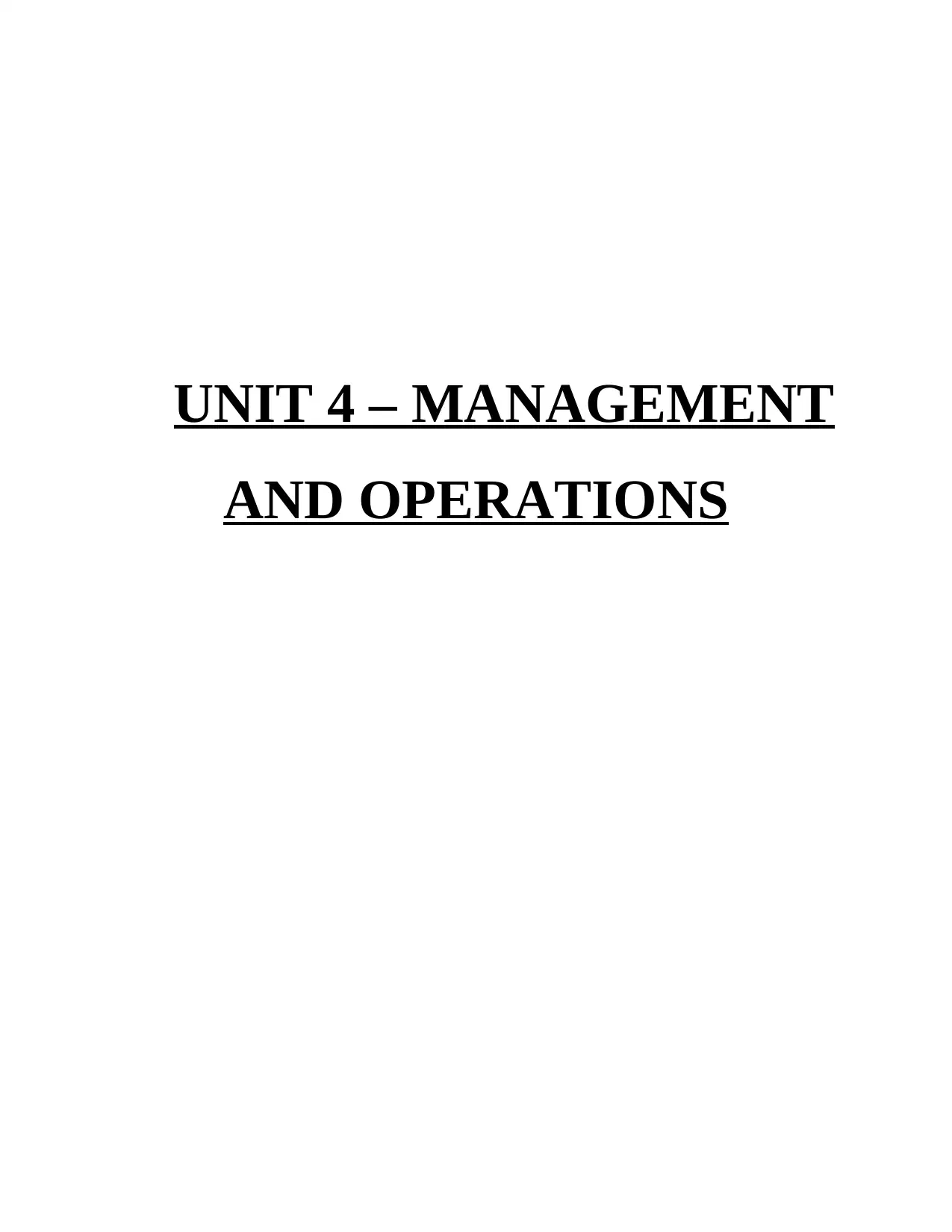
UNIT 4 – MANAGEMENT
AND OPERATIONS
AND OPERATIONS
Secure Best Marks with AI Grader
Need help grading? Try our AI Grader for instant feedback on your assignments.
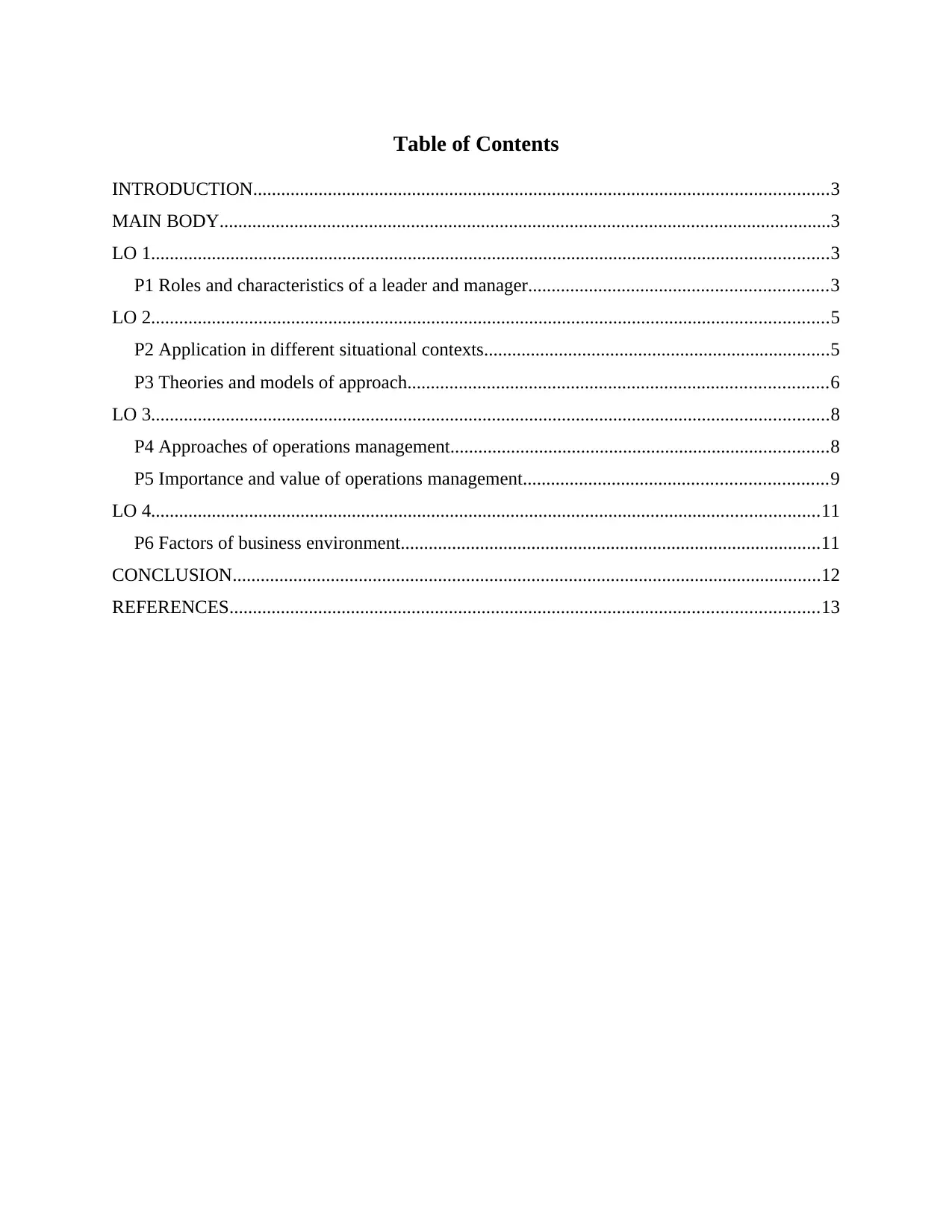
Table of Contents
INTRODUCTION...........................................................................................................................3
MAIN BODY...................................................................................................................................3
LO 1.................................................................................................................................................3
P1 Roles and characteristics of a leader and manager................................................................3
LO 2.................................................................................................................................................5
P2 Application in different situational contexts..........................................................................5
P3 Theories and models of approach..........................................................................................6
LO 3.................................................................................................................................................8
P4 Approaches of operations management.................................................................................8
P5 Importance and value of operations management.................................................................9
LO 4...............................................................................................................................................11
P6 Factors of business environment..........................................................................................11
CONCLUSION..............................................................................................................................12
REFERENCES..............................................................................................................................13
INTRODUCTION...........................................................................................................................3
MAIN BODY...................................................................................................................................3
LO 1.................................................................................................................................................3
P1 Roles and characteristics of a leader and manager................................................................3
LO 2.................................................................................................................................................5
P2 Application in different situational contexts..........................................................................5
P3 Theories and models of approach..........................................................................................6
LO 3.................................................................................................................................................8
P4 Approaches of operations management.................................................................................8
P5 Importance and value of operations management.................................................................9
LO 4...............................................................................................................................................11
P6 Factors of business environment..........................................................................................11
CONCLUSION..............................................................................................................................12
REFERENCES..............................................................................................................................13
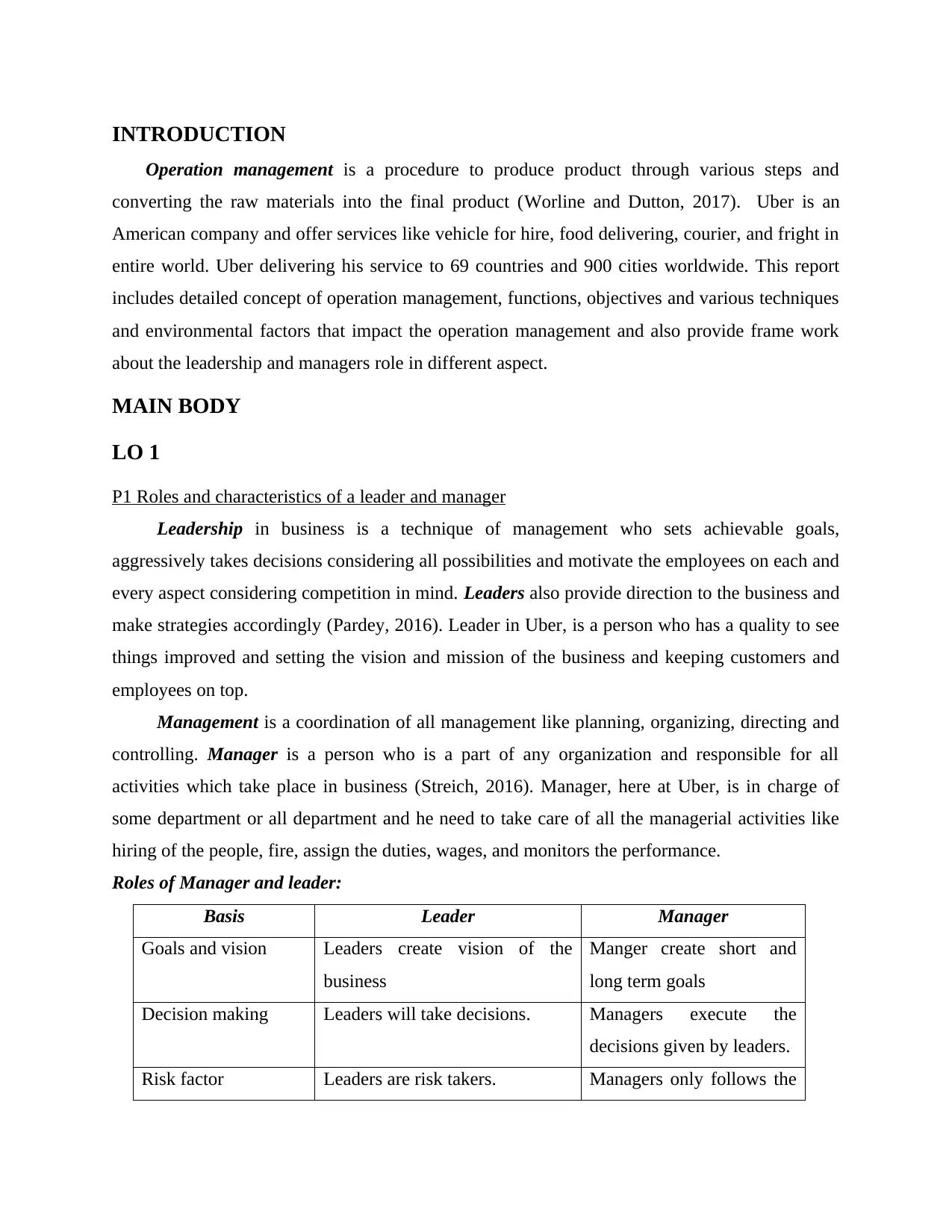
INTRODUCTION
Operation management is a procedure to produce product through various steps and
converting the raw materials into the final product (Worline and Dutton, 2017). Uber is an
American company and offer services like vehicle for hire, food delivering, courier, and fright in
entire world. Uber delivering his service to 69 countries and 900 cities worldwide. This report
includes detailed concept of operation management, functions, objectives and various techniques
and environmental factors that impact the operation management and also provide frame work
about the leadership and managers role in different aspect.
MAIN BODY
LO 1
P1 Roles and characteristics of a leader and manager
Leadership in business is a technique of management who sets achievable goals,
aggressively takes decisions considering all possibilities and motivate the employees on each and
every aspect considering competition in mind. Leaders also provide direction to the business and
make strategies accordingly (Pardey, 2016). Leader in Uber, is a person who has a quality to see
things improved and setting the vision and mission of the business and keeping customers and
employees on top.
Management is a coordination of all management like planning, organizing, directing and
controlling. Manager is a person who is a part of any organization and responsible for all
activities which take place in business (Streich, 2016). Manager, here at Uber, is in charge of
some department or all department and he need to take care of all the managerial activities like
hiring of the people, fire, assign the duties, wages, and monitors the performance.
Roles of Manager and leader:
Basis Leader Manager
Goals and vision Leaders create vision of the
business
Manger create short and
long term goals
Decision making Leaders will take decisions. Managers execute the
decisions given by leaders.
Risk factor Leaders are risk takers. Managers only follows the
Operation management is a procedure to produce product through various steps and
converting the raw materials into the final product (Worline and Dutton, 2017). Uber is an
American company and offer services like vehicle for hire, food delivering, courier, and fright in
entire world. Uber delivering his service to 69 countries and 900 cities worldwide. This report
includes detailed concept of operation management, functions, objectives and various techniques
and environmental factors that impact the operation management and also provide frame work
about the leadership and managers role in different aspect.
MAIN BODY
LO 1
P1 Roles and characteristics of a leader and manager
Leadership in business is a technique of management who sets achievable goals,
aggressively takes decisions considering all possibilities and motivate the employees on each and
every aspect considering competition in mind. Leaders also provide direction to the business and
make strategies accordingly (Pardey, 2016). Leader in Uber, is a person who has a quality to see
things improved and setting the vision and mission of the business and keeping customers and
employees on top.
Management is a coordination of all management like planning, organizing, directing and
controlling. Manager is a person who is a part of any organization and responsible for all
activities which take place in business (Streich, 2016). Manager, here at Uber, is in charge of
some department or all department and he need to take care of all the managerial activities like
hiring of the people, fire, assign the duties, wages, and monitors the performance.
Roles of Manager and leader:
Basis Leader Manager
Goals and vision Leaders create vision of the
business
Manger create short and
long term goals
Decision making Leaders will take decisions. Managers execute the
decisions given by leaders.
Risk factor Leaders are risk takers. Managers only follows the
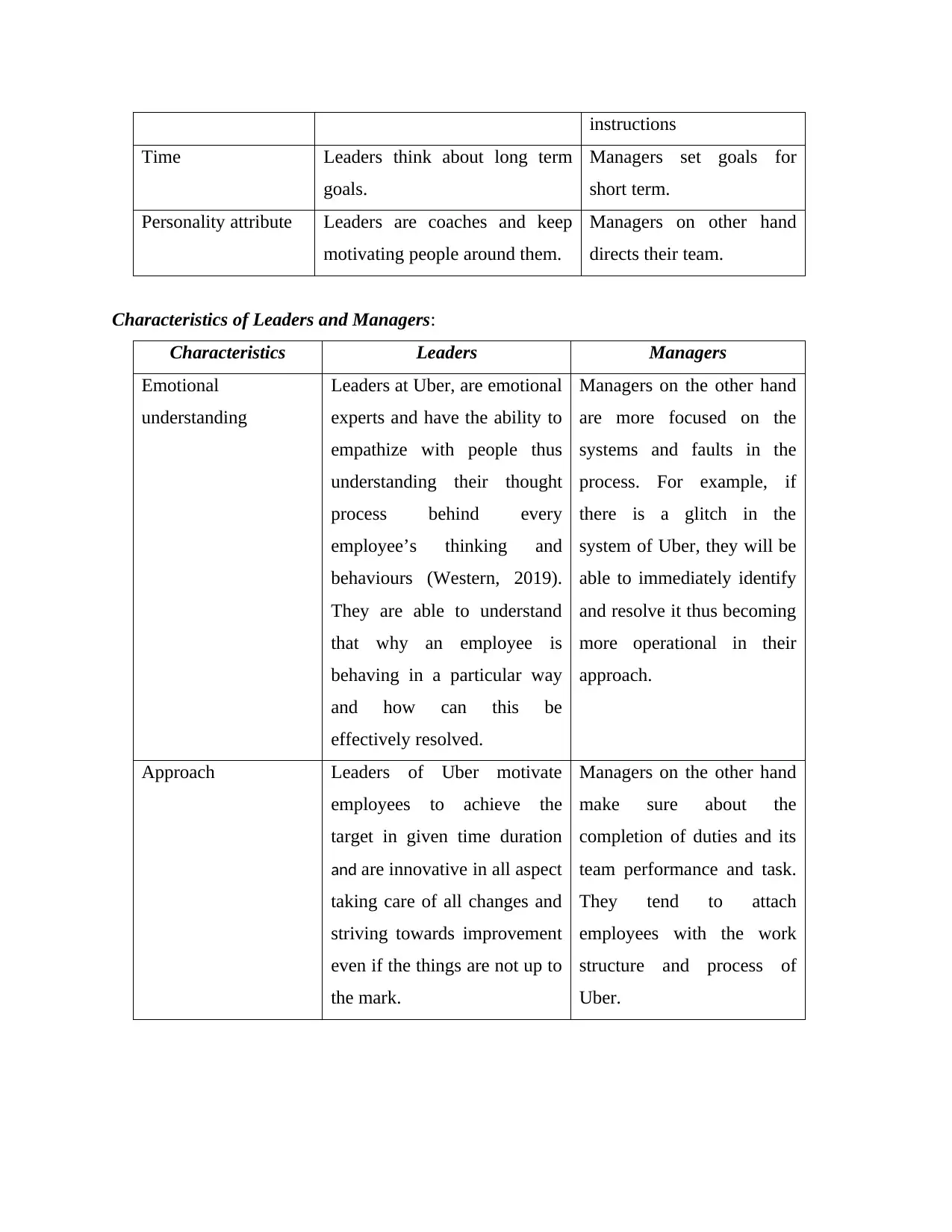
instructions
Time Leaders think about long term
goals.
Managers set goals for
short term.
Personality attribute Leaders are coaches and keep
motivating people around them.
Managers on other hand
directs their team.
Characteristics of Leaders and Managers:
Characteristics Leaders Managers
Emotional
understanding
Leaders at Uber, are emotional
experts and have the ability to
empathize with people thus
understanding their thought
process behind every
employee’s thinking and
behaviours (Western, 2019).
They are able to understand
that why an employee is
behaving in a particular way
and how can this be
effectively resolved.
Managers on the other hand
are more focused on the
systems and faults in the
process. For example, if
there is a glitch in the
system of Uber, they will be
able to immediately identify
and resolve it thus becoming
more operational in their
approach.
Approach Leaders of Uber motivate
employees to achieve the
target in given time duration
and are innovative in all aspect
taking care of all changes and
striving towards improvement
even if the things are not up to
the mark.
Managers on the other hand
make sure about the
completion of duties and its
team performance and task.
They tend to attach
employees with the work
structure and process of
Uber.
Time Leaders think about long term
goals.
Managers set goals for
short term.
Personality attribute Leaders are coaches and keep
motivating people around them.
Managers on other hand
directs their team.
Characteristics of Leaders and Managers:
Characteristics Leaders Managers
Emotional
understanding
Leaders at Uber, are emotional
experts and have the ability to
empathize with people thus
understanding their thought
process behind every
employee’s thinking and
behaviours (Western, 2019).
They are able to understand
that why an employee is
behaving in a particular way
and how can this be
effectively resolved.
Managers on the other hand
are more focused on the
systems and faults in the
process. For example, if
there is a glitch in the
system of Uber, they will be
able to immediately identify
and resolve it thus becoming
more operational in their
approach.
Approach Leaders of Uber motivate
employees to achieve the
target in given time duration
and are innovative in all aspect
taking care of all changes and
striving towards improvement
even if the things are not up to
the mark.
Managers on the other hand
make sure about the
completion of duties and its
team performance and task.
They tend to attach
employees with the work
structure and process of
Uber.
Secure Best Marks with AI Grader
Need help grading? Try our AI Grader for instant feedback on your assignments.
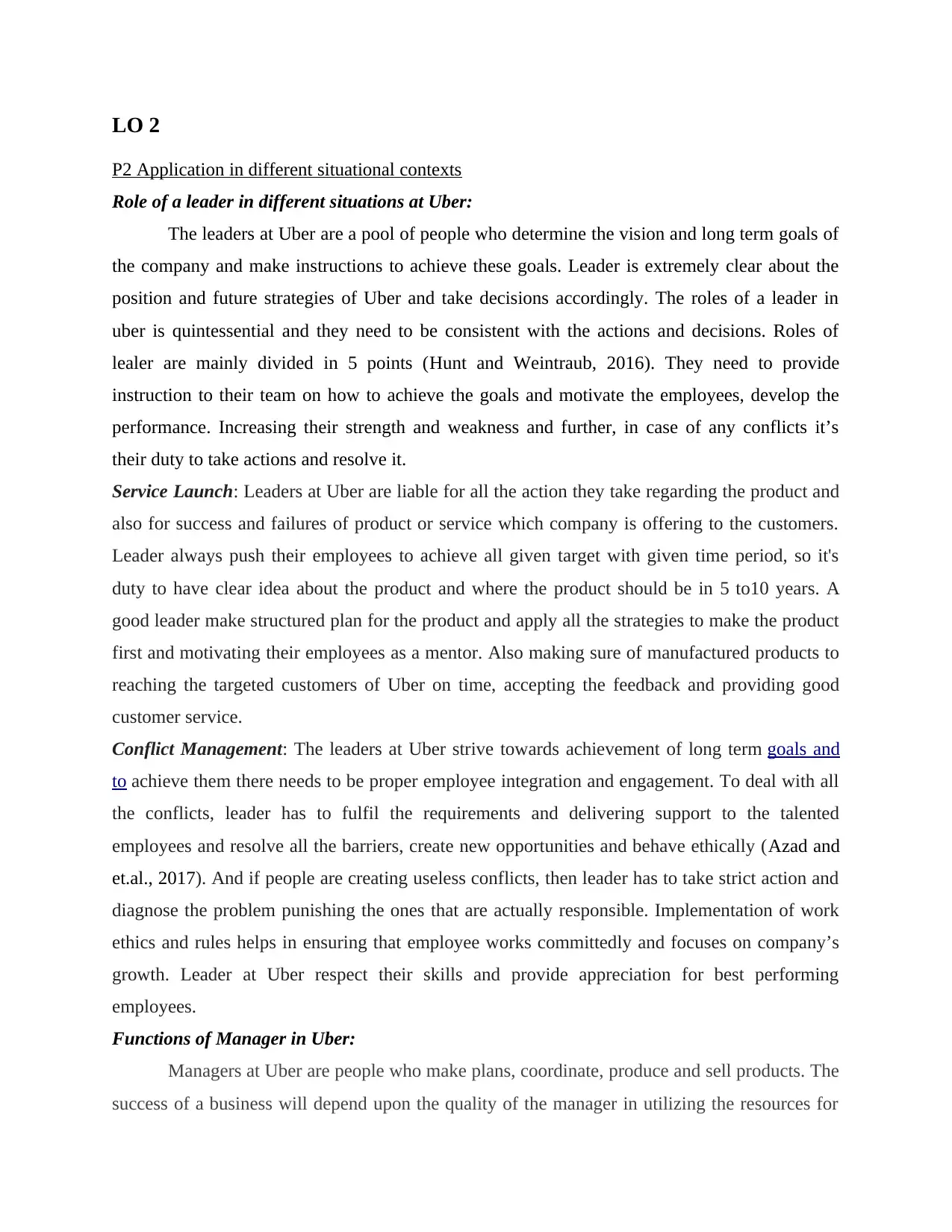
LO 2
P2 Application in different situational contexts
Role of a leader in different situations at Uber:
The leaders at Uber are a pool of people who determine the vision and long term goals of
the company and make instructions to achieve these goals. Leader is extremely clear about the
position and future strategies of Uber and take decisions accordingly. The roles of a leader in
uber is quintessential and they need to be consistent with the actions and decisions. Roles of
lealer are mainly divided in 5 points (Hunt and Weintraub, 2016). They need to provide
instruction to their team on how to achieve the goals and motivate the employees, develop the
performance. Increasing their strength and weakness and further, in case of any conflicts it’s
their duty to take actions and resolve it.
Service Launch: Leaders at Uber are liable for all the action they take regarding the product and
also for success and failures of product or service which company is offering to the customers.
Leader always push their employees to achieve all given target with given time period, so it's
duty to have clear idea about the product and where the product should be in 5 to10 years. A
good leader make structured plan for the product and apply all the strategies to make the product
first and motivating their employees as a mentor. Also making sure of manufactured products to
reaching the targeted customers of Uber on time, accepting the feedback and providing good
customer service.
Conflict Management: The leaders at Uber strive towards achievement of long term goals and
to achieve them there needs to be proper employee integration and engagement. To deal with all
the conflicts, leader has to fulfil the requirements and delivering support to the talented
employees and resolve all the barriers, create new opportunities and behave ethically (Azad and
et.al., 2017). And if people are creating useless conflicts, then leader has to take strict action and
diagnose the problem punishing the ones that are actually responsible. Implementation of work
ethics and rules helps in ensuring that employee works committedly and focuses on company’s
growth. Leader at Uber respect their skills and provide appreciation for best performing
employees.
Functions of Manager in Uber:
Managers at Uber are people who make plans, coordinate, produce and sell products. The
success of a business will depend upon the quality of the manager in utilizing the resources for
P2 Application in different situational contexts
Role of a leader in different situations at Uber:
The leaders at Uber are a pool of people who determine the vision and long term goals of
the company and make instructions to achieve these goals. Leader is extremely clear about the
position and future strategies of Uber and take decisions accordingly. The roles of a leader in
uber is quintessential and they need to be consistent with the actions and decisions. Roles of
lealer are mainly divided in 5 points (Hunt and Weintraub, 2016). They need to provide
instruction to their team on how to achieve the goals and motivate the employees, develop the
performance. Increasing their strength and weakness and further, in case of any conflicts it’s
their duty to take actions and resolve it.
Service Launch: Leaders at Uber are liable for all the action they take regarding the product and
also for success and failures of product or service which company is offering to the customers.
Leader always push their employees to achieve all given target with given time period, so it's
duty to have clear idea about the product and where the product should be in 5 to10 years. A
good leader make structured plan for the product and apply all the strategies to make the product
first and motivating their employees as a mentor. Also making sure of manufactured products to
reaching the targeted customers of Uber on time, accepting the feedback and providing good
customer service.
Conflict Management: The leaders at Uber strive towards achievement of long term goals and
to achieve them there needs to be proper employee integration and engagement. To deal with all
the conflicts, leader has to fulfil the requirements and delivering support to the talented
employees and resolve all the barriers, create new opportunities and behave ethically (Azad and
et.al., 2017). And if people are creating useless conflicts, then leader has to take strict action and
diagnose the problem punishing the ones that are actually responsible. Implementation of work
ethics and rules helps in ensuring that employee works committedly and focuses on company’s
growth. Leader at Uber respect their skills and provide appreciation for best performing
employees.
Functions of Manager in Uber:
Managers at Uber are people who make plans, coordinate, produce and sell products. The
success of a business will depend upon the quality of the manager in utilizing the resources for
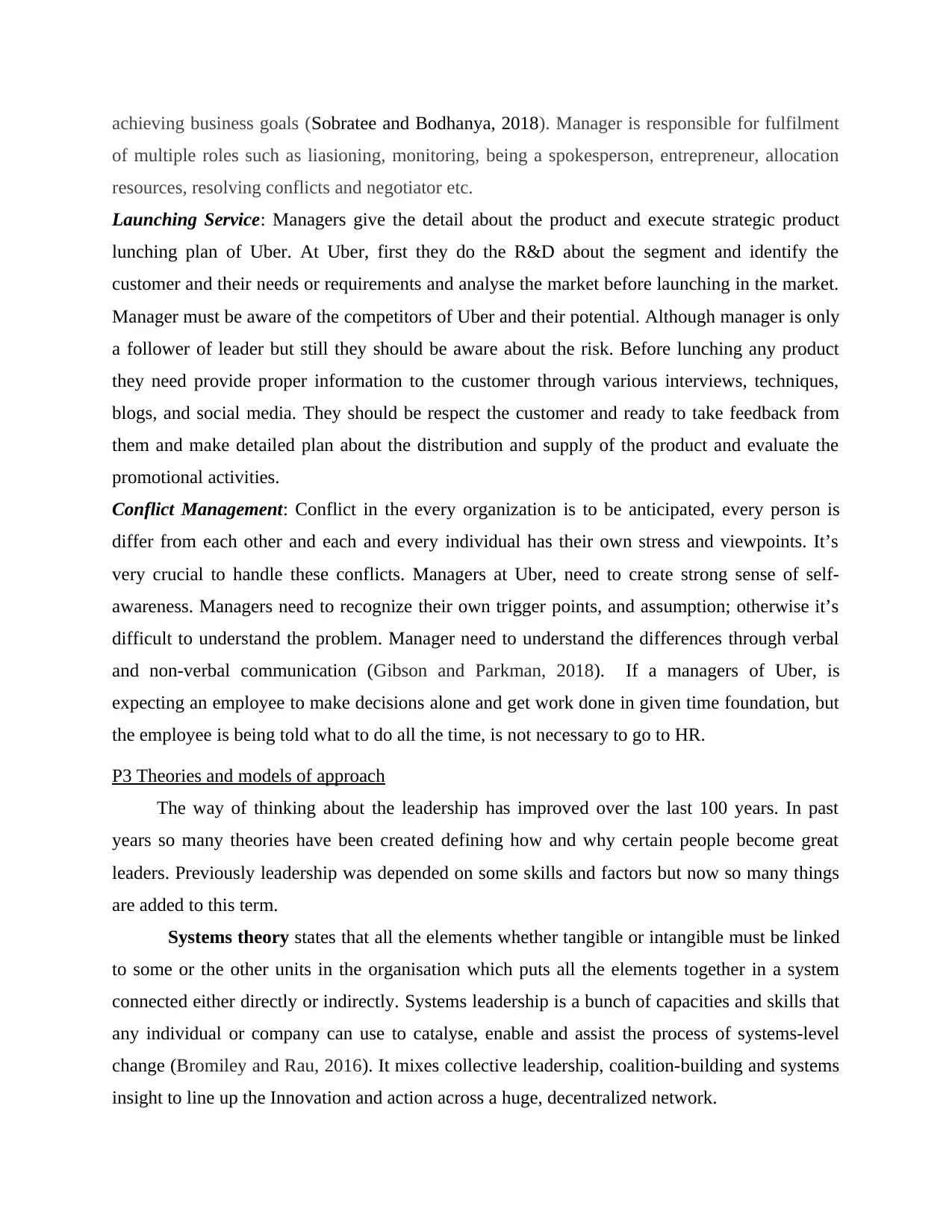
achieving business goals (Sobratee and Bodhanya, 2018). Manager is responsible for fulfilment
of multiple roles such as liasioning, monitoring, being a spokesperson, entrepreneur, allocation
resources, resolving conflicts and negotiator etc.
Launching Service: Managers give the detail about the product and execute strategic product
lunching plan of Uber. At Uber, first they do the R&D about the segment and identify the
customer and their needs or requirements and analyse the market before launching in the market.
Manager must be aware of the competitors of Uber and their potential. Although manager is only
a follower of leader but still they should be aware about the risk. Before lunching any product
they need provide proper information to the customer through various interviews, techniques,
blogs, and social media. They should be respect the customer and ready to take feedback from
them and make detailed plan about the distribution and supply of the product and evaluate the
promotional activities.
Conflict Management: Conflict in the every organization is to be anticipated, every person is
differ from each other and each and every individual has their own stress and viewpoints. It’s
very crucial to handle these conflicts. Managers at Uber, need to create strong sense of self-
awareness. Managers need to recognize their own trigger points, and assumption; otherwise it’s
difficult to understand the problem. Manager need to understand the differences through verbal
and non-verbal communication (Gibson and Parkman, 2018). If a managers of Uber, is
expecting an employee to make decisions alone and get work done in given time foundation, but
the employee is being told what to do all the time, is not necessary to go to HR.
P3 Theories and models of approach
The way of thinking about the leadership has improved over the last 100 years. In past
years so many theories have been created defining how and why certain people become great
leaders. Previously leadership was depended on some skills and factors but now so many things
are added to this term.
Systems theory states that all the elements whether tangible or intangible must be linked
to some or the other units in the organisation which puts all the elements together in a system
connected either directly or indirectly. Systems leadership is a bunch of capacities and skills that
any individual or company can use to catalyse, enable and assist the process of systems-level
change (Bromiley and Rau, 2016). It mixes collective leadership, coalition-building and systems
insight to line up the Innovation and action across a huge, decentralized network.
of multiple roles such as liasioning, monitoring, being a spokesperson, entrepreneur, allocation
resources, resolving conflicts and negotiator etc.
Launching Service: Managers give the detail about the product and execute strategic product
lunching plan of Uber. At Uber, first they do the R&D about the segment and identify the
customer and their needs or requirements and analyse the market before launching in the market.
Manager must be aware of the competitors of Uber and their potential. Although manager is only
a follower of leader but still they should be aware about the risk. Before lunching any product
they need provide proper information to the customer through various interviews, techniques,
blogs, and social media. They should be respect the customer and ready to take feedback from
them and make detailed plan about the distribution and supply of the product and evaluate the
promotional activities.
Conflict Management: Conflict in the every organization is to be anticipated, every person is
differ from each other and each and every individual has their own stress and viewpoints. It’s
very crucial to handle these conflicts. Managers at Uber, need to create strong sense of self-
awareness. Managers need to recognize their own trigger points, and assumption; otherwise it’s
difficult to understand the problem. Manager need to understand the differences through verbal
and non-verbal communication (Gibson and Parkman, 2018). If a managers of Uber, is
expecting an employee to make decisions alone and get work done in given time foundation, but
the employee is being told what to do all the time, is not necessary to go to HR.
P3 Theories and models of approach
The way of thinking about the leadership has improved over the last 100 years. In past
years so many theories have been created defining how and why certain people become great
leaders. Previously leadership was depended on some skills and factors but now so many things
are added to this term.
Systems theory states that all the elements whether tangible or intangible must be linked
to some or the other units in the organisation which puts all the elements together in a system
connected either directly or indirectly. Systems leadership is a bunch of capacities and skills that
any individual or company can use to catalyse, enable and assist the process of systems-level
change (Bromiley and Rau, 2016). It mixes collective leadership, coalition-building and systems
insight to line up the Innovation and action across a huge, decentralized network.
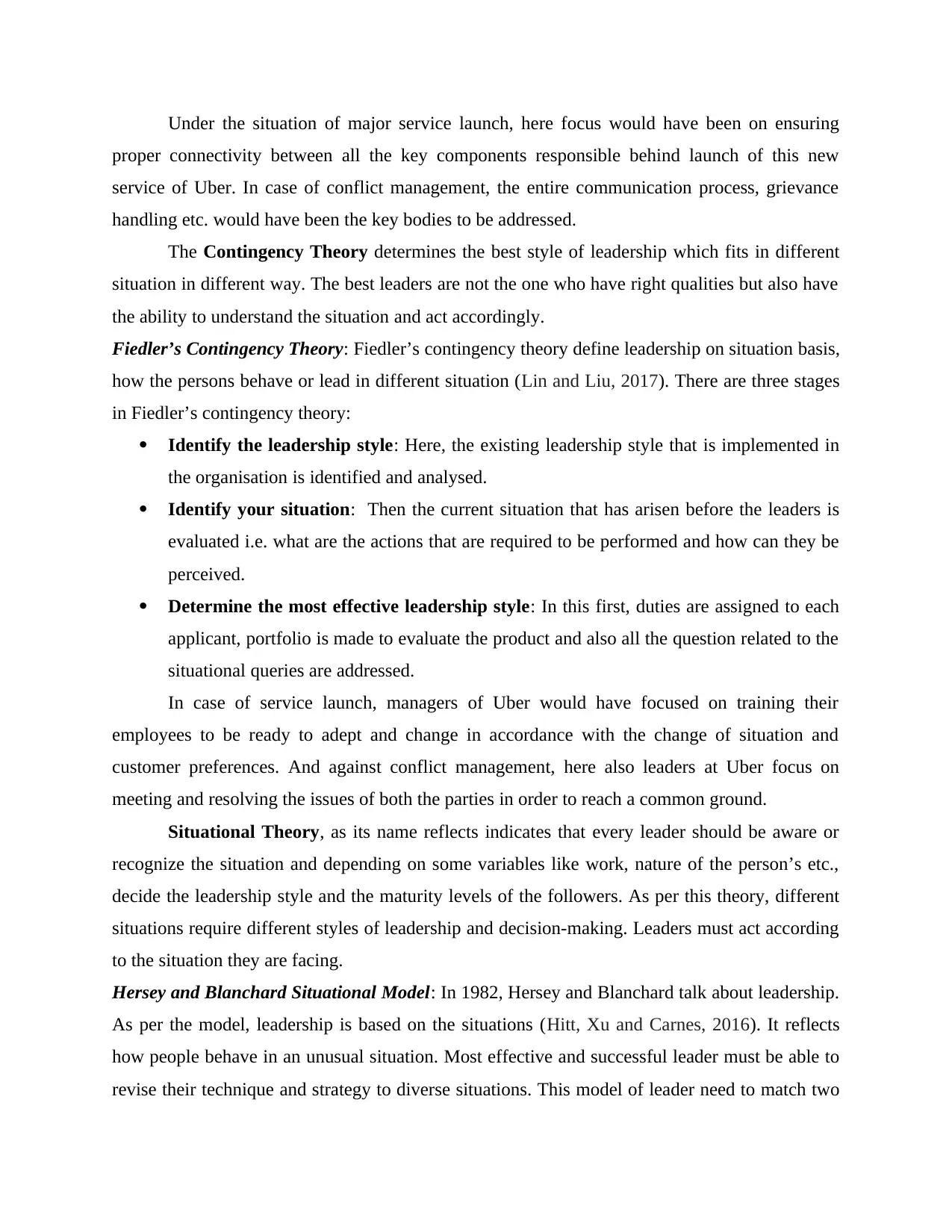
Under the situation of major service launch, here focus would have been on ensuring
proper connectivity between all the key components responsible behind launch of this new
service of Uber. In case of conflict management, the entire communication process, grievance
handling etc. would have been the key bodies to be addressed.
The Contingency Theory determines the best style of leadership which fits in different
situation in different way. The best leaders are not the one who have right qualities but also have
the ability to understand the situation and act accordingly.
Fiedler’s Contingency Theory: Fiedler’s contingency theory define leadership on situation basis,
how the persons behave or lead in different situation (Lin and Liu, 2017). There are three stages
in Fiedler’s contingency theory:
Identify the leadership style: Here, the existing leadership style that is implemented in
the organisation is identified and analysed.
Identify your situation: Then the current situation that has arisen before the leaders is
evaluated i.e. what are the actions that are required to be performed and how can they be
perceived.
Determine the most effective leadership style: In this first, duties are assigned to each
applicant, portfolio is made to evaluate the product and also all the question related to the
situational queries are addressed.
In case of service launch, managers of Uber would have focused on training their
employees to be ready to adept and change in accordance with the change of situation and
customer preferences. And against conflict management, here also leaders at Uber focus on
meeting and resolving the issues of both the parties in order to reach a common ground.
Situational Theory, as its name reflects indicates that every leader should be aware or
recognize the situation and depending on some variables like work, nature of the person’s etc.,
decide the leadership style and the maturity levels of the followers. As per this theory, different
situations require different styles of leadership and decision-making. Leaders must act according
to the situation they are facing.
Hersey and Blanchard Situational Model: In 1982, Hersey and Blanchard talk about leadership.
As per the model, leadership is based on the situations (Hitt, Xu and Carnes, 2016). It reflects
how people behave in an unusual situation. Most effective and successful leader must be able to
revise their technique and strategy to diverse situations. This model of leader need to match two
proper connectivity between all the key components responsible behind launch of this new
service of Uber. In case of conflict management, the entire communication process, grievance
handling etc. would have been the key bodies to be addressed.
The Contingency Theory determines the best style of leadership which fits in different
situation in different way. The best leaders are not the one who have right qualities but also have
the ability to understand the situation and act accordingly.
Fiedler’s Contingency Theory: Fiedler’s contingency theory define leadership on situation basis,
how the persons behave or lead in different situation (Lin and Liu, 2017). There are three stages
in Fiedler’s contingency theory:
Identify the leadership style: Here, the existing leadership style that is implemented in
the organisation is identified and analysed.
Identify your situation: Then the current situation that has arisen before the leaders is
evaluated i.e. what are the actions that are required to be performed and how can they be
perceived.
Determine the most effective leadership style: In this first, duties are assigned to each
applicant, portfolio is made to evaluate the product and also all the question related to the
situational queries are addressed.
In case of service launch, managers of Uber would have focused on training their
employees to be ready to adept and change in accordance with the change of situation and
customer preferences. And against conflict management, here also leaders at Uber focus on
meeting and resolving the issues of both the parties in order to reach a common ground.
Situational Theory, as its name reflects indicates that every leader should be aware or
recognize the situation and depending on some variables like work, nature of the person’s etc.,
decide the leadership style and the maturity levels of the followers. As per this theory, different
situations require different styles of leadership and decision-making. Leaders must act according
to the situation they are facing.
Hersey and Blanchard Situational Model: In 1982, Hersey and Blanchard talk about leadership.
As per the model, leadership is based on the situations (Hitt, Xu and Carnes, 2016). It reflects
how people behave in an unusual situation. Most effective and successful leader must be able to
revise their technique and strategy to diverse situations. This model of leader need to match two
Paraphrase This Document
Need a fresh take? Get an instant paraphrase of this document with our AI Paraphraser
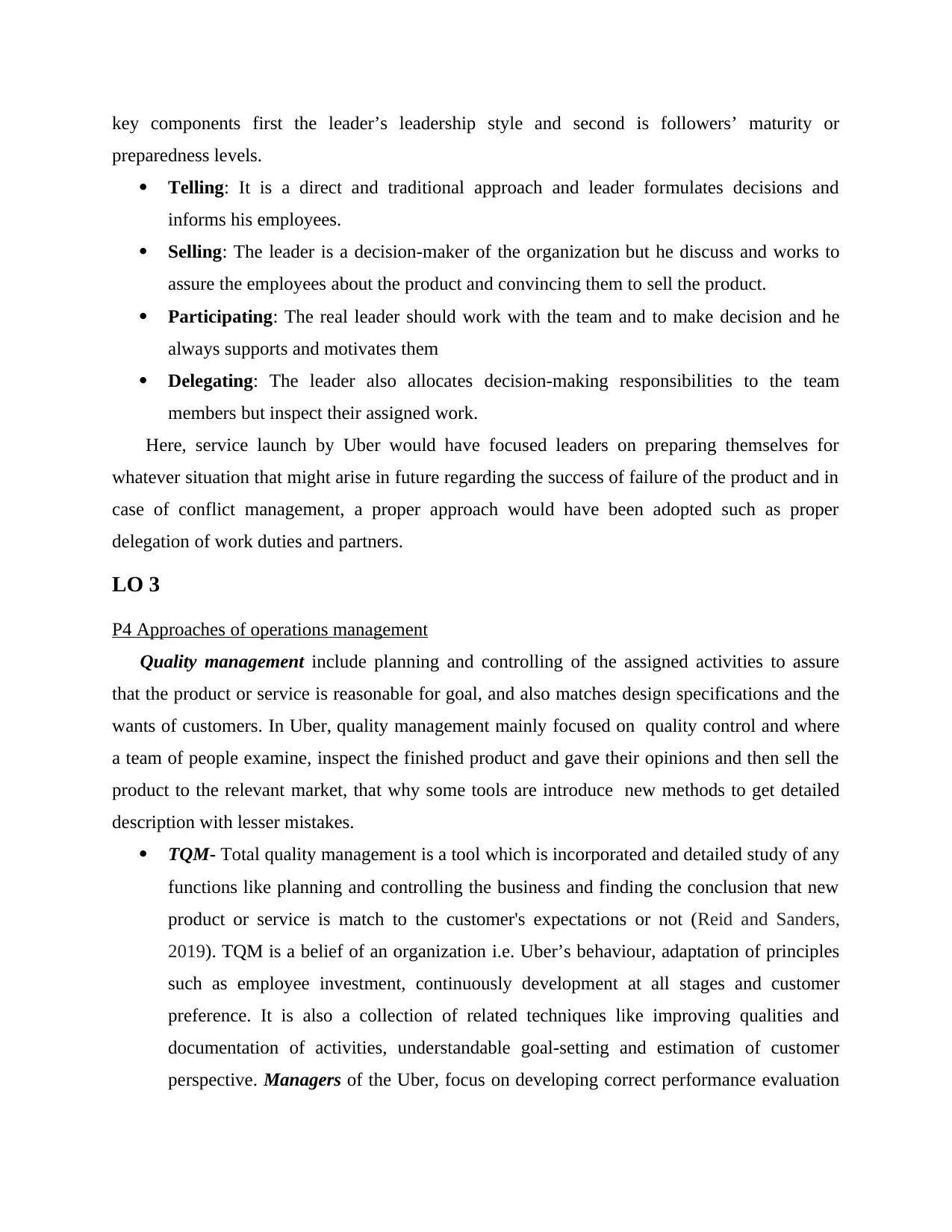
key components first the leader’s leadership style and second is followers’ maturity or
preparedness levels.
Telling: It is a direct and traditional approach and leader formulates decisions and
informs his employees.
Selling: The leader is a decision-maker of the organization but he discuss and works to
assure the employees about the product and convincing them to sell the product.
Participating: The real leader should work with the team and to make decision and he
always supports and motivates them
Delegating: The leader also allocates decision-making responsibilities to the team
members but inspect their assigned work.
Here, service launch by Uber would have focused leaders on preparing themselves for
whatever situation that might arise in future regarding the success of failure of the product and in
case of conflict management, a proper approach would have been adopted such as proper
delegation of work duties and partners.
LO 3
P4 Approaches of operations management
Quality management include planning and controlling of the assigned activities to assure
that the product or service is reasonable for goal, and also matches design specifications and the
wants of customers. In Uber, quality management mainly focused on quality control and where
a team of people examine, inspect the finished product and gave their opinions and then sell the
product to the relevant market, that why some tools are introduce new methods to get detailed
description with lesser mistakes.
TQM- Total quality management is a tool which is incorporated and detailed study of any
functions like planning and controlling the business and finding the conclusion that new
product or service is match to the customer's expectations or not (Reid and Sanders,
2019). TQM is a belief of an organization i.e. Uber’s behaviour, adaptation of principles
such as employee investment, continuously development at all stages and customer
preference. It is also a collection of related techniques like improving qualities and
documentation of activities, understandable goal-setting and estimation of customer
perspective. Managers of the Uber, focus on developing correct performance evaluation
preparedness levels.
Telling: It is a direct and traditional approach and leader formulates decisions and
informs his employees.
Selling: The leader is a decision-maker of the organization but he discuss and works to
assure the employees about the product and convincing them to sell the product.
Participating: The real leader should work with the team and to make decision and he
always supports and motivates them
Delegating: The leader also allocates decision-making responsibilities to the team
members but inspect their assigned work.
Here, service launch by Uber would have focused leaders on preparing themselves for
whatever situation that might arise in future regarding the success of failure of the product and in
case of conflict management, a proper approach would have been adopted such as proper
delegation of work duties and partners.
LO 3
P4 Approaches of operations management
Quality management include planning and controlling of the assigned activities to assure
that the product or service is reasonable for goal, and also matches design specifications and the
wants of customers. In Uber, quality management mainly focused on quality control and where
a team of people examine, inspect the finished product and gave their opinions and then sell the
product to the relevant market, that why some tools are introduce new methods to get detailed
description with lesser mistakes.
TQM- Total quality management is a tool which is incorporated and detailed study of any
functions like planning and controlling the business and finding the conclusion that new
product or service is match to the customer's expectations or not (Reid and Sanders,
2019). TQM is a belief of an organization i.e. Uber’s behaviour, adaptation of principles
such as employee investment, continuously development at all stages and customer
preference. It is also a collection of related techniques like improving qualities and
documentation of activities, understandable goal-setting and estimation of customer
perspective. Managers of the Uber, focus on developing correct performance evaluation
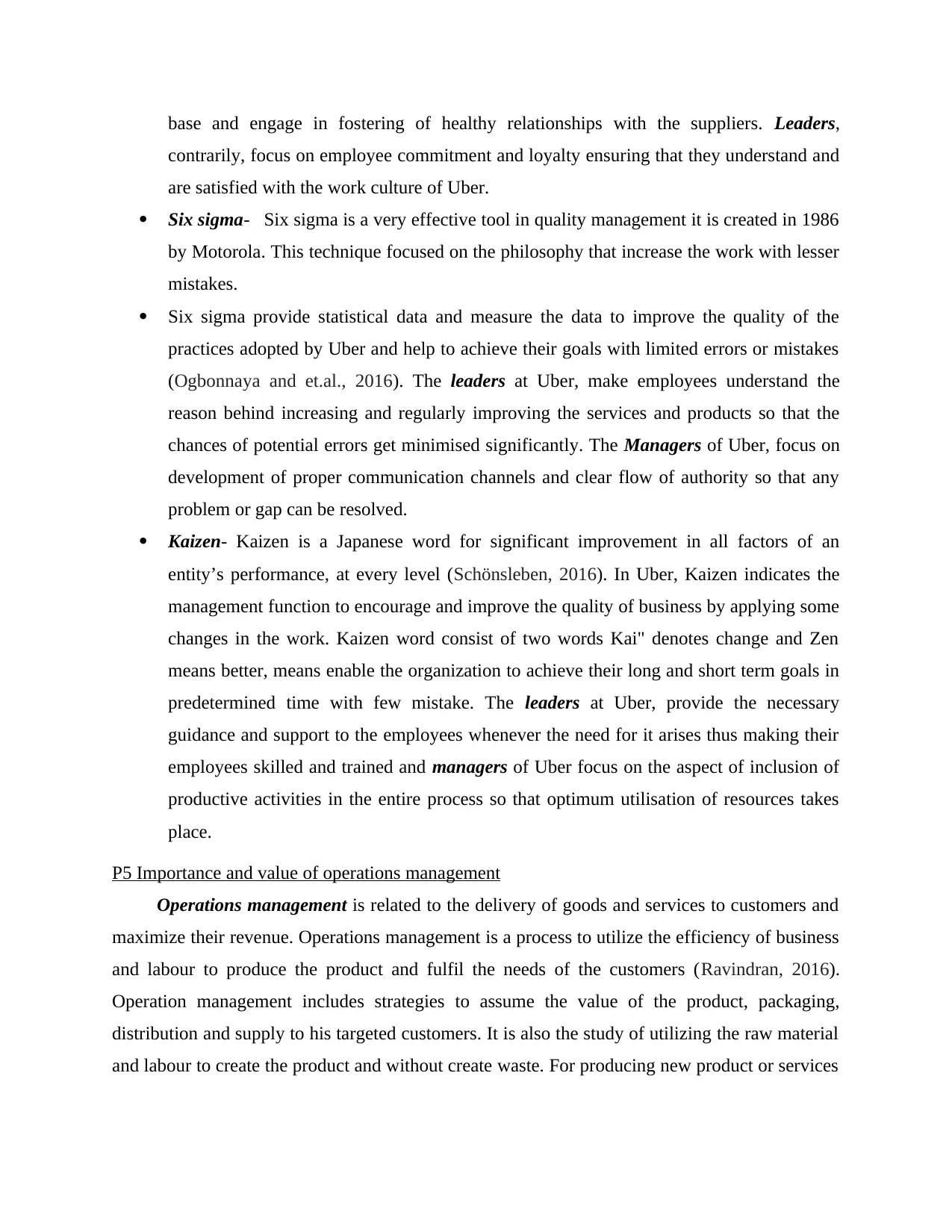
base and engage in fostering of healthy relationships with the suppliers. Leaders,
contrarily, focus on employee commitment and loyalty ensuring that they understand and
are satisfied with the work culture of Uber.
Six sigma- Six sigma is a very effective tool in quality management it is created in 1986
by Motorola. This technique focused on the philosophy that increase the work with lesser
mistakes.
Six sigma provide statistical data and measure the data to improve the quality of the
practices adopted by Uber and help to achieve their goals with limited errors or mistakes
(Ogbonnaya and et.al., 2016). The leaders at Uber, make employees understand the
reason behind increasing and regularly improving the services and products so that the
chances of potential errors get minimised significantly. The Managers of Uber, focus on
development of proper communication channels and clear flow of authority so that any
problem or gap can be resolved.
Kaizen- Kaizen is a Japanese word for significant improvement in all factors of an
entity’s performance, at every level (Schönsleben, 2016). In Uber, Kaizen indicates the
management function to encourage and improve the quality of business by applying some
changes in the work. Kaizen word consist of two words Kai" denotes change and Zen
means better, means enable the organization to achieve their long and short term goals in
predetermined time with few mistake. The leaders at Uber, provide the necessary
guidance and support to the employees whenever the need for it arises thus making their
employees skilled and trained and managers of Uber focus on the aspect of inclusion of
productive activities in the entire process so that optimum utilisation of resources takes
place.
P5 Importance and value of operations management
Operations management is related to the delivery of goods and services to customers and
maximize their revenue. Operations management is a process to utilize the efficiency of business
and labour to produce the product and fulfil the needs of the customers (Ravindran, 2016).
Operation management includes strategies to assume the value of the product, packaging,
distribution and supply to his targeted customers. It is also the study of utilizing the raw material
and labour to create the product and without create waste. For producing new product or services
contrarily, focus on employee commitment and loyalty ensuring that they understand and
are satisfied with the work culture of Uber.
Six sigma- Six sigma is a very effective tool in quality management it is created in 1986
by Motorola. This technique focused on the philosophy that increase the work with lesser
mistakes.
Six sigma provide statistical data and measure the data to improve the quality of the
practices adopted by Uber and help to achieve their goals with limited errors or mistakes
(Ogbonnaya and et.al., 2016). The leaders at Uber, make employees understand the
reason behind increasing and regularly improving the services and products so that the
chances of potential errors get minimised significantly. The Managers of Uber, focus on
development of proper communication channels and clear flow of authority so that any
problem or gap can be resolved.
Kaizen- Kaizen is a Japanese word for significant improvement in all factors of an
entity’s performance, at every level (Schönsleben, 2016). In Uber, Kaizen indicates the
management function to encourage and improve the quality of business by applying some
changes in the work. Kaizen word consist of two words Kai" denotes change and Zen
means better, means enable the organization to achieve their long and short term goals in
predetermined time with few mistake. The leaders at Uber, provide the necessary
guidance and support to the employees whenever the need for it arises thus making their
employees skilled and trained and managers of Uber focus on the aspect of inclusion of
productive activities in the entire process so that optimum utilisation of resources takes
place.
P5 Importance and value of operations management
Operations management is related to the delivery of goods and services to customers and
maximize their revenue. Operations management is a process to utilize the efficiency of business
and labour to produce the product and fulfil the needs of the customers (Ravindran, 2016).
Operation management includes strategies to assume the value of the product, packaging,
distribution and supply to his targeted customers. It is also the study of utilizing the raw material
and labour to create the product and without create waste. For producing new product or services
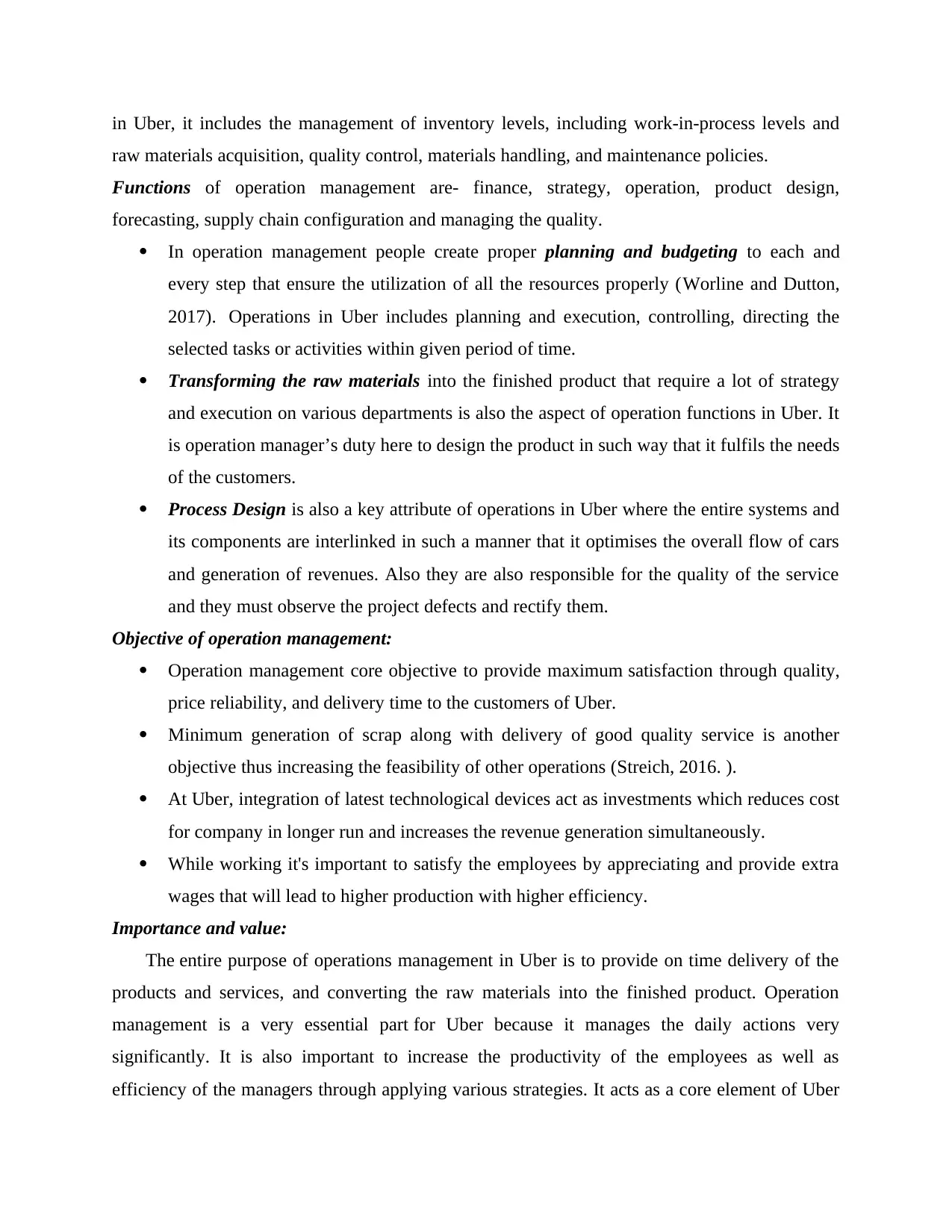
in Uber, it includes the management of inventory levels, including work-in-process levels and
raw materials acquisition, quality control, materials handling, and maintenance policies.
Functions of operation management are- finance, strategy, operation, product design,
forecasting, supply chain configuration and managing the quality.
In operation management people create proper planning and budgeting to each and
every step that ensure the utilization of all the resources properly (Worline and Dutton,
2017). Operations in Uber includes planning and execution, controlling, directing the
selected tasks or activities within given period of time.
Transforming the raw materials into the finished product that require a lot of strategy
and execution on various departments is also the aspect of operation functions in Uber. It
is operation manager’s duty here to design the product in such way that it fulfils the needs
of the customers.
Process Design is also a key attribute of operations in Uber where the entire systems and
its components are interlinked in such a manner that it optimises the overall flow of cars
and generation of revenues. Also they are also responsible for the quality of the service
and they must observe the project defects and rectify them.
Objective of operation management:
Operation management core objective to provide maximum satisfaction through quality,
price reliability, and delivery time to the customers of Uber.
Minimum generation of scrap along with delivery of good quality service is another
objective thus increasing the feasibility of other operations (Streich, 2016. ).
At Uber, integration of latest technological devices act as investments which reduces cost
for company in longer run and increases the revenue generation simultaneously.
While working it's important to satisfy the employees by appreciating and provide extra
wages that will lead to higher production with higher efficiency.
Importance and value:
The entire purpose of operations management in Uber is to provide on time delivery of the
products and services, and converting the raw materials into the finished product. Operation
management is a very essential part for Uber because it manages the daily actions very
significantly. It is also important to increase the productivity of the employees as well as
efficiency of the managers through applying various strategies. It acts as a core element of Uber
raw materials acquisition, quality control, materials handling, and maintenance policies.
Functions of operation management are- finance, strategy, operation, product design,
forecasting, supply chain configuration and managing the quality.
In operation management people create proper planning and budgeting to each and
every step that ensure the utilization of all the resources properly (Worline and Dutton,
2017). Operations in Uber includes planning and execution, controlling, directing the
selected tasks or activities within given period of time.
Transforming the raw materials into the finished product that require a lot of strategy
and execution on various departments is also the aspect of operation functions in Uber. It
is operation manager’s duty here to design the product in such way that it fulfils the needs
of the customers.
Process Design is also a key attribute of operations in Uber where the entire systems and
its components are interlinked in such a manner that it optimises the overall flow of cars
and generation of revenues. Also they are also responsible for the quality of the service
and they must observe the project defects and rectify them.
Objective of operation management:
Operation management core objective to provide maximum satisfaction through quality,
price reliability, and delivery time to the customers of Uber.
Minimum generation of scrap along with delivery of good quality service is another
objective thus increasing the feasibility of other operations (Streich, 2016. ).
At Uber, integration of latest technological devices act as investments which reduces cost
for company in longer run and increases the revenue generation simultaneously.
While working it's important to satisfy the employees by appreciating and provide extra
wages that will lead to higher production with higher efficiency.
Importance and value:
The entire purpose of operations management in Uber is to provide on time delivery of the
products and services, and converting the raw materials into the finished product. Operation
management is a very essential part for Uber because it manages the daily actions very
significantly. It is also important to increase the productivity of the employees as well as
efficiency of the managers through applying various strategies. It acts as a core element of Uber
Secure Best Marks with AI Grader
Need help grading? Try our AI Grader for instant feedback on your assignments.
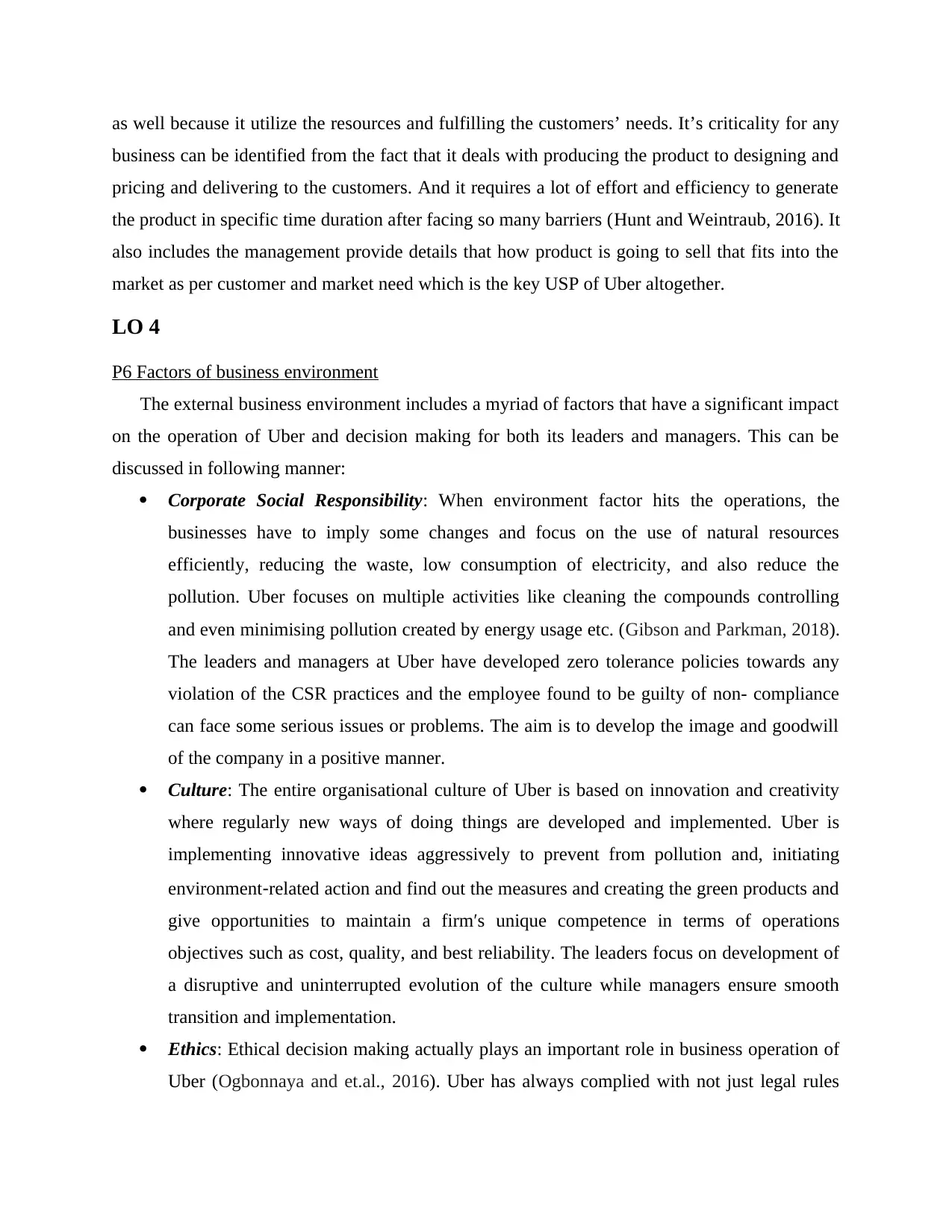
as well because it utilize the resources and fulfilling the customers’ needs. It’s criticality for any
business can be identified from the fact that it deals with producing the product to designing and
pricing and delivering to the customers. And it requires a lot of effort and efficiency to generate
the product in specific time duration after facing so many barriers (Hunt and Weintraub, 2016). It
also includes the management provide details that how product is going to sell that fits into the
market as per customer and market need which is the key USP of Uber altogether.
LO 4
P6 Factors of business environment
The external business environment includes a myriad of factors that have a significant impact
on the operation of Uber and decision making for both its leaders and managers. This can be
discussed in following manner:
Corporate Social Responsibility: When environment factor hits the operations, the
businesses have to imply some changes and focus on the use of natural resources
efficiently, reducing the waste, low consumption of electricity, and also reduce the
pollution. Uber focuses on multiple activities like cleaning the compounds controlling
and even minimising pollution created by energy usage etc. (Gibson and Parkman, 2018).
The leaders and managers at Uber have developed zero tolerance policies towards any
violation of the CSR practices and the employee found to be guilty of non- compliance
can face some serious issues or problems. The aim is to develop the image and goodwill
of the company in a positive manner.
Culture: The entire organisational culture of Uber is based on innovation and creativity
where regularly new ways of doing things are developed and implemented. Uber is
implementing innovative ideas aggressively to prevent from pollution and, initiating
environment‐related action and find out the measures and creating the green products and
give opportunities to maintain a firm′s unique competence in terms of operations
objectives such as cost, quality, and best reliability. The leaders focus on development of
a disruptive and uninterrupted evolution of the culture while managers ensure smooth
transition and implementation.
Ethics: Ethical decision making actually plays an important role in business operation of
Uber (Ogbonnaya and et.al., 2016). Uber has always complied with not just legal rules
business can be identified from the fact that it deals with producing the product to designing and
pricing and delivering to the customers. And it requires a lot of effort and efficiency to generate
the product in specific time duration after facing so many barriers (Hunt and Weintraub, 2016). It
also includes the management provide details that how product is going to sell that fits into the
market as per customer and market need which is the key USP of Uber altogether.
LO 4
P6 Factors of business environment
The external business environment includes a myriad of factors that have a significant impact
on the operation of Uber and decision making for both its leaders and managers. This can be
discussed in following manner:
Corporate Social Responsibility: When environment factor hits the operations, the
businesses have to imply some changes and focus on the use of natural resources
efficiently, reducing the waste, low consumption of electricity, and also reduce the
pollution. Uber focuses on multiple activities like cleaning the compounds controlling
and even minimising pollution created by energy usage etc. (Gibson and Parkman, 2018).
The leaders and managers at Uber have developed zero tolerance policies towards any
violation of the CSR practices and the employee found to be guilty of non- compliance
can face some serious issues or problems. The aim is to develop the image and goodwill
of the company in a positive manner.
Culture: The entire organisational culture of Uber is based on innovation and creativity
where regularly new ways of doing things are developed and implemented. Uber is
implementing innovative ideas aggressively to prevent from pollution and, initiating
environment‐related action and find out the measures and creating the green products and
give opportunities to maintain a firm′s unique competence in terms of operations
objectives such as cost, quality, and best reliability. The leaders focus on development of
a disruptive and uninterrupted evolution of the culture while managers ensure smooth
transition and implementation.
Ethics: Ethical decision making actually plays an important role in business operation of
Uber (Ogbonnaya and et.al., 2016). Uber has always complied with not just legal rules
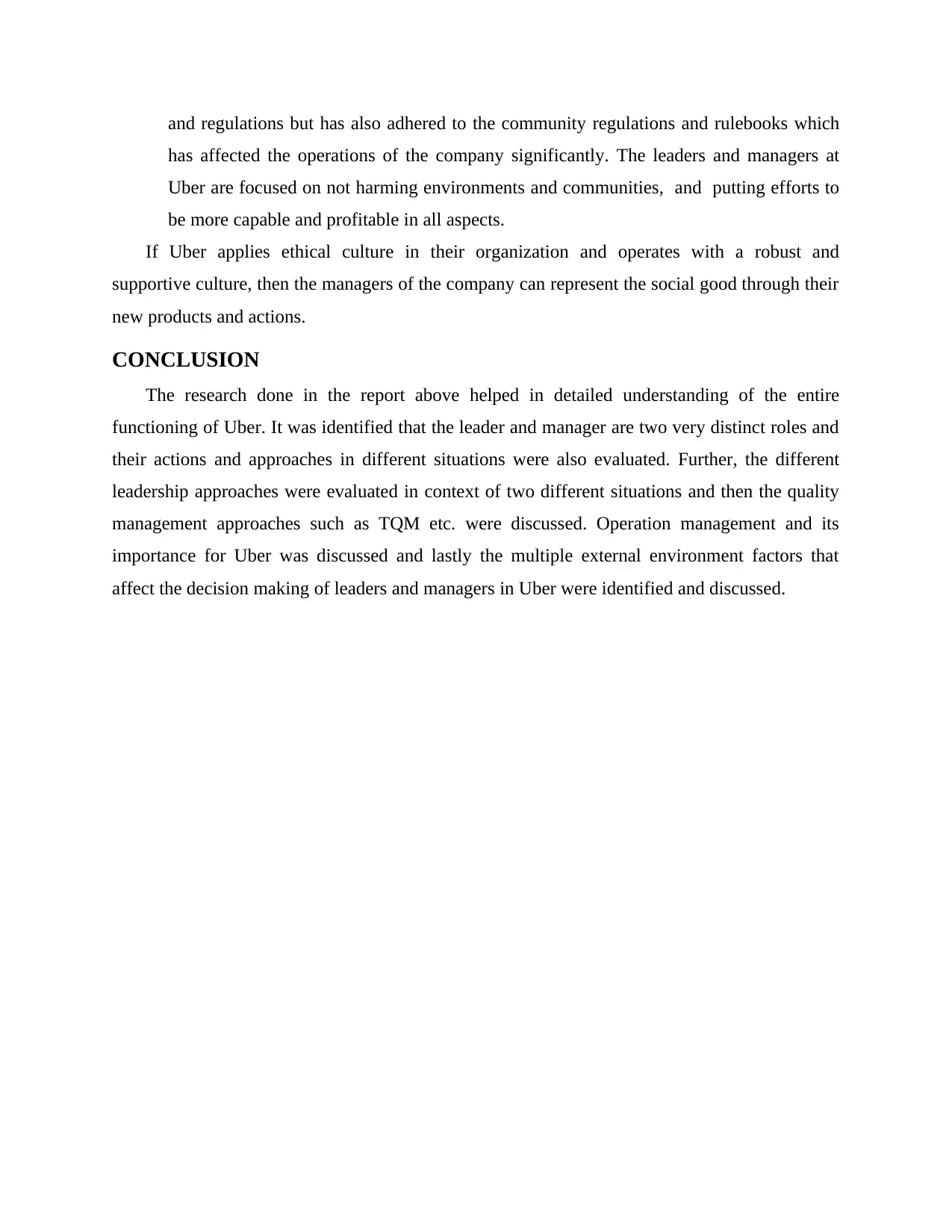
and regulations but has also adhered to the community regulations and rulebooks which
has affected the operations of the company significantly. The leaders and managers at
Uber are focused on not harming environments and communities, and putting efforts to
be more capable and profitable in all aspects.
If Uber applies ethical culture in their organization and operates with a robust and
supportive culture, then the managers of the company can represent the social good through their
new products and actions.
CONCLUSION
The research done in the report above helped in detailed understanding of the entire
functioning of Uber. It was identified that the leader and manager are two very distinct roles and
their actions and approaches in different situations were also evaluated. Further, the different
leadership approaches were evaluated in context of two different situations and then the quality
management approaches such as TQM etc. were discussed. Operation management and its
importance for Uber was discussed and lastly the multiple external environment factors that
affect the decision making of leaders and managers in Uber were identified and discussed.
has affected the operations of the company significantly. The leaders and managers at
Uber are focused on not harming environments and communities, and putting efforts to
be more capable and profitable in all aspects.
If Uber applies ethical culture in their organization and operates with a robust and
supportive culture, then the managers of the company can represent the social good through their
new products and actions.
CONCLUSION
The research done in the report above helped in detailed understanding of the entire
functioning of Uber. It was identified that the leader and manager are two very distinct roles and
their actions and approaches in different situations were also evaluated. Further, the different
leadership approaches were evaluated in context of two different situations and then the quality
management approaches such as TQM etc. were discussed. Operation management and its
importance for Uber was discussed and lastly the multiple external environment factors that
affect the decision making of leaders and managers in Uber were identified and discussed.
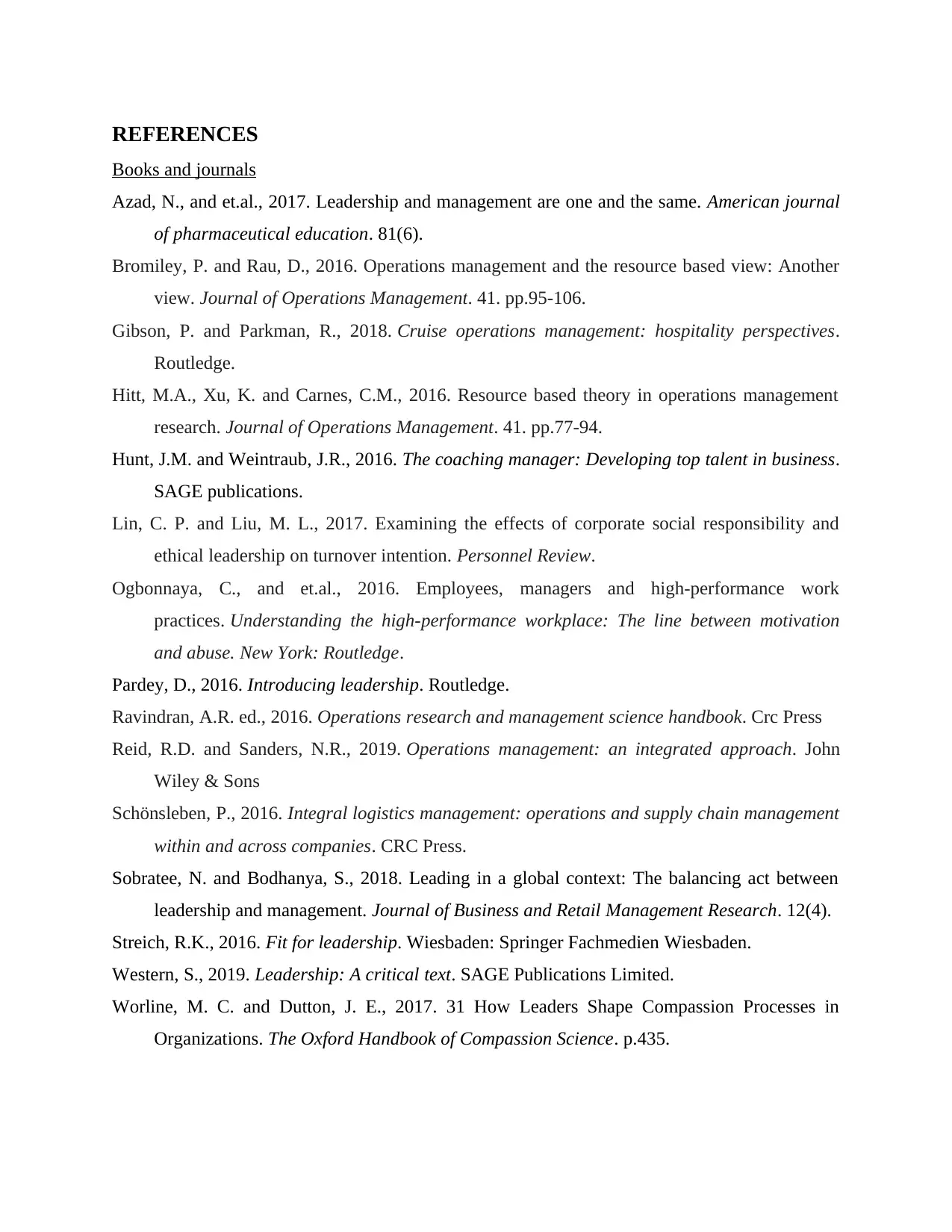
REFERENCES
Books and journals
Azad, N., and et.al., 2017. Leadership and management are one and the same. American journal
of pharmaceutical education. 81(6).
Bromiley, P. and Rau, D., 2016. Operations management and the resource based view: Another
view. Journal of Operations Management. 41. pp.95-106.
Gibson, P. and Parkman, R., 2018. Cruise operations management: hospitality perspectives.
Routledge.
Hitt, M.A., Xu, K. and Carnes, C.M., 2016. Resource based theory in operations management
research. Journal of Operations Management. 41. pp.77-94.
Hunt, J.M. and Weintraub, J.R., 2016. The coaching manager: Developing top talent in business.
SAGE publications.
Lin, C. P. and Liu, M. L., 2017. Examining the effects of corporate social responsibility and
ethical leadership on turnover intention. Personnel Review.
Ogbonnaya, C., and et.al., 2016. Employees, managers and high-performance work
practices. Understanding the high-performance workplace: The line between motivation
and abuse. New York: Routledge.
Pardey, D., 2016. Introducing leadership. Routledge.
Ravindran, A.R. ed., 2016. Operations research and management science handbook. Crc Press
Reid, R.D. and Sanders, N.R., 2019. Operations management: an integrated approach. John
Wiley & Sons
Schönsleben, P., 2016. Integral logistics management: operations and supply chain management
within and across companies. CRC Press.
Sobratee, N. and Bodhanya, S., 2018. Leading in a global context: The balancing act between
leadership and management. Journal of Business and Retail Management Research. 12(4).
Streich, R.K., 2016. Fit for leadership. Wiesbaden: Springer Fachmedien Wiesbaden.
Western, S., 2019. Leadership: A critical text. SAGE Publications Limited.
Worline, M. C. and Dutton, J. E., 2017. 31 How Leaders Shape Compassion Processes in
Organizations. The Oxford Handbook of Compassion Science. p.435.
Books and journals
Azad, N., and et.al., 2017. Leadership and management are one and the same. American journal
of pharmaceutical education. 81(6).
Bromiley, P. and Rau, D., 2016. Operations management and the resource based view: Another
view. Journal of Operations Management. 41. pp.95-106.
Gibson, P. and Parkman, R., 2018. Cruise operations management: hospitality perspectives.
Routledge.
Hitt, M.A., Xu, K. and Carnes, C.M., 2016. Resource based theory in operations management
research. Journal of Operations Management. 41. pp.77-94.
Hunt, J.M. and Weintraub, J.R., 2016. The coaching manager: Developing top talent in business.
SAGE publications.
Lin, C. P. and Liu, M. L., 2017. Examining the effects of corporate social responsibility and
ethical leadership on turnover intention. Personnel Review.
Ogbonnaya, C., and et.al., 2016. Employees, managers and high-performance work
practices. Understanding the high-performance workplace: The line between motivation
and abuse. New York: Routledge.
Pardey, D., 2016. Introducing leadership. Routledge.
Ravindran, A.R. ed., 2016. Operations research and management science handbook. Crc Press
Reid, R.D. and Sanders, N.R., 2019. Operations management: an integrated approach. John
Wiley & Sons
Schönsleben, P., 2016. Integral logistics management: operations and supply chain management
within and across companies. CRC Press.
Sobratee, N. and Bodhanya, S., 2018. Leading in a global context: The balancing act between
leadership and management. Journal of Business and Retail Management Research. 12(4).
Streich, R.K., 2016. Fit for leadership. Wiesbaden: Springer Fachmedien Wiesbaden.
Western, S., 2019. Leadership: A critical text. SAGE Publications Limited.
Worline, M. C. and Dutton, J. E., 2017. 31 How Leaders Shape Compassion Processes in
Organizations. The Oxford Handbook of Compassion Science. p.435.
1 out of 13
Related Documents
Your All-in-One AI-Powered Toolkit for Academic Success.
+13062052269
info@desklib.com
Available 24*7 on WhatsApp / Email
![[object Object]](/_next/static/media/star-bottom.7253800d.svg)
Unlock your academic potential
© 2024 | Zucol Services PVT LTD | All rights reserved.





